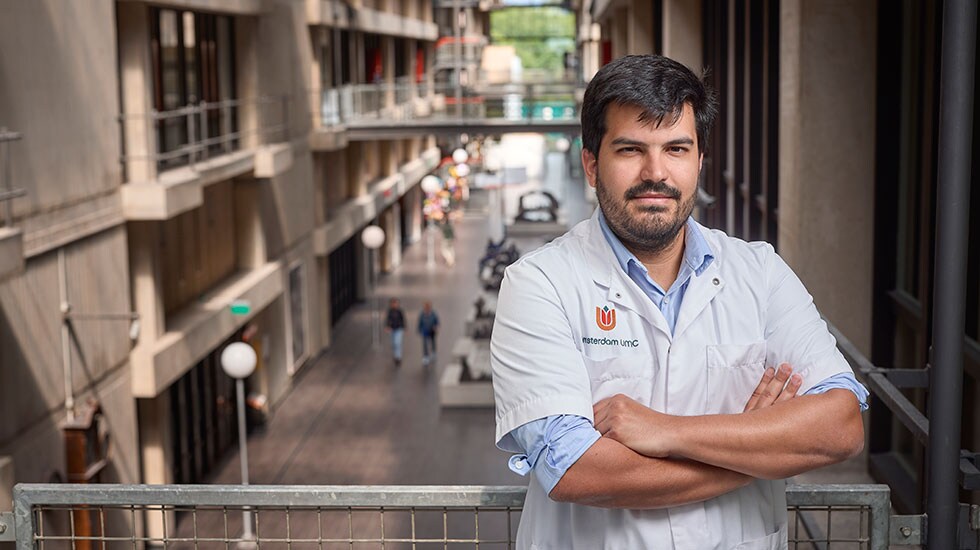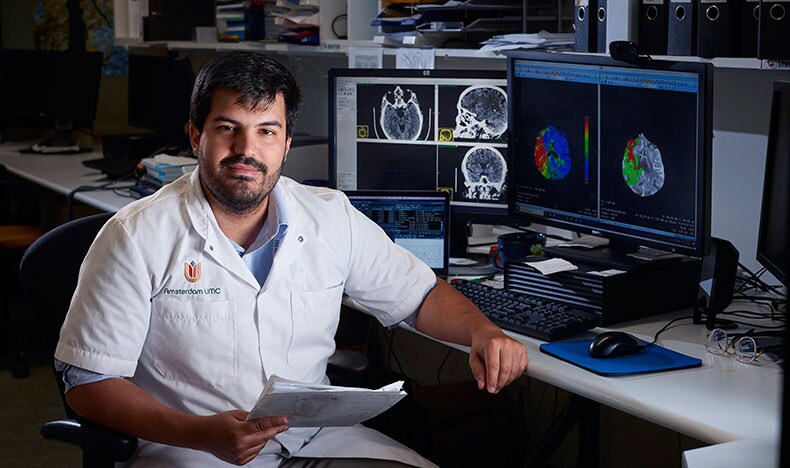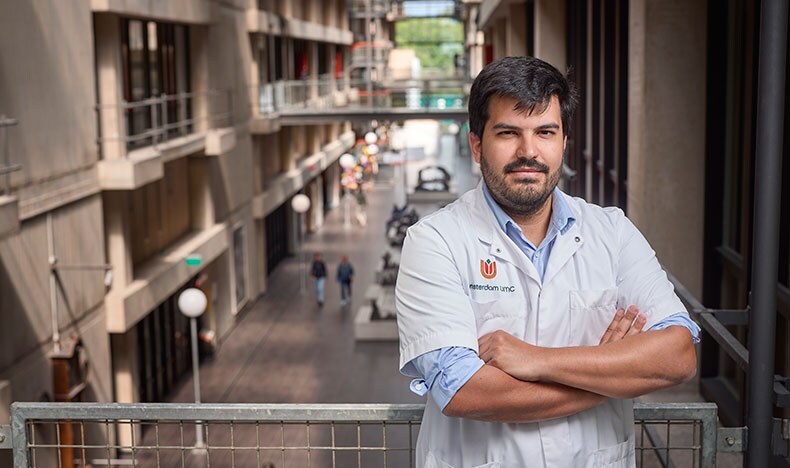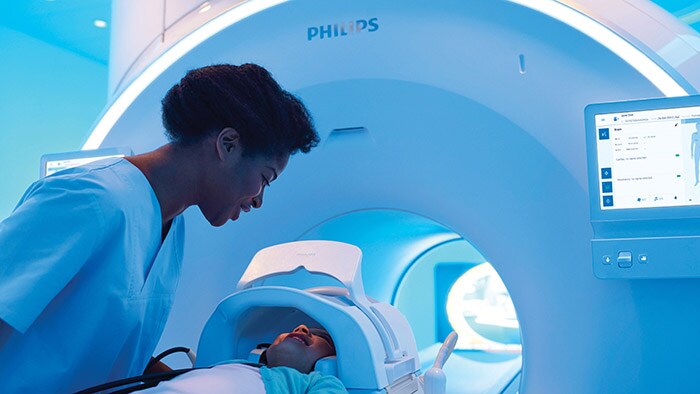Fabiano Cavalcante wint Ziedses de Plantes-prijs 2024 voor meta-analyse naar beroertebehandeling
jun 10, 2024 | 4 minuten leestijd
Gegevens combineren van niet één, maar zes gerandomiseerde klinische onderzoeken om de beste behandeling voor beroertes te onderzoeken. Dat is de kracht van het onderzoek uitgevoerd door Fabiano Cavalcante, promovendus aan het Amsterdam UMC, naar beroertebehandeling. Deze meta-analyse leverde hem de Ziedses des Plantes-prijs 2024 op. Het onderzoek met zijn team richtte zich op de effectiviteit van intraveneuze alteplase voor patiënten die direct endovasculaire therapie kunnen ontvangen en biedt nieuwe inzichten en mogelijke verbeteringen in de behandeling van deze levensbedreigende ziekte.

Acute ischemische beroerte wordt veroorzaakt door de blokkade van een of meer slagaders die bloed naar de hersenen voeren, meestal door een bloedstolsel (trombus). Dit is een belangrijke oorzaak van invaliditeit en sterfte wereldwijd. Richtlijnen bevelen aan dat alle in aanmerking komende patiënten behandeld moeten worden met intraveneuze alteplase, een medicijn dat bloedstolsels oplost. Hoewel dit medicijn revolutionair was toen het werd geïntroduceerd, heeft het een beperkte effectiviteit bij grote stolsels en kan het leiden tot ernstige bijwerkingen zoals intracraniale bloedingen.
Effectief
“In de jaren 90 werd het medicijn alteplase goedgekeurd als de eerste effectieve behandeling voor beroertes. Er is geen twijfel dat deze behandeling effectief is bij de algemene beroertepopulatie”, zegt Cavalcante. In 2015 veranderde de beroertebehandeling met de introductie van endovasculaire behandeling, een minimaal invasieve medische procedure om bloedvaten van binnenuit te behandelen. “Er zijn dus twee behandelingen mogelijk en we weten niet of deze behandelingen elkaar helpen. Dus voor patiënten die direct naar centra gaan die endovasculaire behandeling kunnen uitvoeren, moeten we dan nog steeds intraveneuze alteplase toedienen? Is het geven van beide behandelingen beter? En als we het geven, helpt het dan of schaadt het de patiënt?”, zegt Cavalcante over de reden voor het onderzoek.
Meta-analyse
Het onderzoek richtte zich op de behandeling van acute ischemische beroerte en onderzoekt de effectiviteit van endovasculaire behandeling met of zonder intraveneuze alteplase. Hij en zijn team combineerden de datasets van zes klinische onderzoeken in China, Japan, Europa en Australië/Zuid-Oost Azië in de IRIS-samenwerking. Cavalcante: “Door deze datasets te combineren, kregen we een onderzoekspopulatie van meer dan tweeduizend patiënten. Zo konden we onderzoeken op individueel deelnemersniveau met betere statistische precisie.”
Interessante resultaten
Cavalcante vindt de resultaten van het onderzoek interessant. Volgens hem zagen ze geen significante voordelen van de combinatie van behandelingen vergeleken met alleen endovasculaire behandeling. Het kwam daarnaast ook niet duidelijk naar voren dat het medicijn schadelijk zou kunnen zijn. “De huidige richtlijnen bevelen aan dat patiënten zowel endovasculaire behandeling als intraveneuze alteplase moeten krijgen, maar we zagen geen duidelijk voordeel in het combineren van behandelingen vergeleken met alleen endovasculaire behandeling”, zegt hij.

Gepersonaliseerde aanpak
Is het voorschrijven van intraveneuze alteplase nog steeds nodig voor patiënten die direct endovasculaire behandeling kunnen ontvangen? “Misschien verschilt dat van patiënt tot patiënt en van situatie tot situatie”, zegt Cavalcante. Het onderzoek suggereert dat het belangrijk is om te kijken naar een gepersonaliseerde benadering voor de behandeling van acute ischemische beroertes. “Artsen moeten mogelijk patiëntspecifieke factoren in overweging nemen bij het beslissen of alteplase moet worden gebruikt naast endovasculaire behandeling.” De onderzoeksgroep onderzoekt meerdere wegen van vervolgonderzoek, bijvoorbeeld om te onderzoeken welke patiënten wel of geen alteplase moeten krijgen.
IRIS-samenwerking
Een groep van bijzonder belang zijn patiënten met een laesie in de halsslagader (bijvoorbeeld cholesterolplaques). Deze laesies worden soms behandeld tijdens de endovasculaire procedure en wanneer dat gebeurt zijn extra medicijnen nodig. In combinatie met alteplase zouden deze medicijnen het risico op bloedingen kunnen verhogen en daarom was er twijfel binnen de beroertegemeenschap over of alteplase aan deze patiënten moet worden gegeven of dat ze direct naar de endovasculaire behandeling moeten gaan. Het onderzoek naar dit onderwerp door Cavalcante en de IRIS-samenwerking heeft interessante resultaten opgeleverd over de effectiviteit en veiligheid van alteplase vóór endovasculaire behandeling voor deze patiënten.
Slimme samenwerking
De meta-analyse leverde Cavalcante de Ziedses des Plantes-prijs 2024 op, wat hem natuurlijk trots maakt. En hij vindt het een grote verantwoordelijkheid omdat hij er samen met een grote groep mensen aan werkte. “We kunnen natuurlijk meer doen met een grote groep slimme mensen van over de hele wereld. Dit resultaat laat zien dat samenwerking in onderzoek erg belangrijk is. Ik sta echt versteld van hoeveel we samen hebben bereikt. Dit maakt de lange nachten en de stress meer dan waard”, zegt hij trots.
Over de Ziedses des Plantes-prijs
Elk jaar reiken de Nederlandse Vereniging voor Interventie Radiologie (NVIR) en Philips de Ziedses des Plantes-prijs uit. De prijs is vernoemd naar prof. dr. B.G. Ziedses des Plantes, een van de grootste pioniers op het gebied van radiologie en uitvinder van de planigrafie, waarmee hij de weg vrijmaakte voor de ontwikkeling van CT en MRI. Met deze prijs wil Philips de innovatie in het vakgebied belonen en stimuleren. De prijswinnaars van dit jaar zijn Pim Hendriks (LUMC) en Fabiano Cavalcante (AUMC).
Lees hier het interview met Pim Hendriks, de andere winnaar van de Ziedses des Plantes-prijs 2024.
Fabiano Cavalcante Wins Ziedses des Plantes Award 2024 for Stroke Treatment Meta-Analysis
Combining data from not one, but six randomized clinical trials to research the best treatment for strokes. That is the strength of the research conducted by Fabiano Cavalcante, PhD candidate at Amsterdam UMC, into stroke treatment. This meta-analysis earned him the Ziedses des Plantes Award 2024. The research he conducted with his team focused on the effectiveness of intravenous alteplase for patients who can directly receive endovascular therapy. It provides new insights and potential improvements in the treatment of this life-threatening disease.

Acute ischemic stroke is caused by the blockage of one or more arteries that supply blood to the brain, usually by a blood clot (thrombus). This is a major cause of disability and death worldwide. Guidelines recommend that all eligible patients should be treated with intravenous alteplase, a medication that dissolves blood clots. Although this medication was revolutionary when introduced, it has limited effectiveness with large clots and can lead to serious side effects such as intracranial bleeding.
Effective
“In the 1990s, the drug alteplase was approved as the first effective treatment for stroke. There is no doubt that this treatment is effective in the general stroke population,” says Cavalcante. In 2015, stroke treatment changed with the introduction of endovascular treatment, a minimally invasive medical procedure to treat blood vessels from the inside. “So there are two treatments possible, and we do not know if these treatments help each other. For patients presenting directly to centers capable of performing endovascular treatment, should we still give intravenous alteplase? Is giving both treatments better? And if we do give it, is it helping or harming the patient?” says Cavalcante about the reason for the research.
Meta-Analysis
Cavalcante's research focused on the treatment of acute ischemic stroke and examines the effectiveness of endovascular treatment with or without intravenous alteplase. He and his team combined the datasets of six clinical trials in China, Japan, Europe, and Australia/Southeast Asia in the IRIS collaboration. Cavalcante: “By combining these datasets, we obtained a study population of more than two thousand patients. This allowed us to investigate at the individual participant level, with better statistical precision.”
Interesting Results
Cavalcante finds the results of the research interesting. According to him, they did not see significant benefits of the combination of treatments compared to just endovascular treatment. It also did not clearly emerge that the medication could be harmful. “Current guidelines recommend that patients should receive both endovascular treatment and intravenous alteplase, but we did not see a clear benefit in favor of the combined treatments when compared to patients receiving endovascular treatment alone,” he says.

Personalized Approach
Is prescribing intravenous alteplase still necessary for patients who can directly receive endovascular treatment? Perhaps that varies from patient to patient and situation to situation, says Cavalcante. The research suggests that it is important to look at a personalized approach to the treatment of acute ischemic strokes. Doctors may need to consider patient-specific factors when deciding whether alteplase should be used alongside endovascular treatment. The research group is exploring multiple paths of further research, for example, to investigate which patients should or should not receive alteplase.
IRIS collaboration
A group of particular interest includes patients with a lesion in the carotid artery (for example cholesterol plaques). These lesions are sometimes treated during the endovascular procedure and when that happens additional medications are needed. In combination with alteplase, these medications could increase the risk of bleeding and so there was doubt among the stroke community about whether alteplase should be given to these patients or if they should go directly to the endovascular treatment. The study investigating this topic by Fabiano Cavalcante and the IRIS collaboration has provided interesting results about the efficacy and safety of alteplase before endovascular treatment for these patients.
Smart Collaboration
The meta-analysis earned Cavalcante the Ziedses des Plantes Award 2024, which of course makes him proud. And he finds it a great responsibility because he worked on it together with a large group of people. "Of course, we can do more with a large group of smart people from all over the world. This result shows that collaborating in research is very important. I am truly amazed at how much we have achieved together. This makes the long nights and the stress more than worth it," he says proudly.
About the Ziedses des Plantes Award
Every year, the Dutch Society for Interventional Radiology (NVIR) and Philips award the Ziedses des Plantes Award. The prize is named after Prof. Dr. B.G. Ziedses des Plantes, one of the greatest pioneers in the field of radiology and the inventor of planigraphy, which paved the way for the development of CT and MRI. With this award, Philips aims to reward and stimulate innovation in the field. This year's winners are Pim Hendriks (LUMC) and Fabiano Cavalcante (AUMC).








